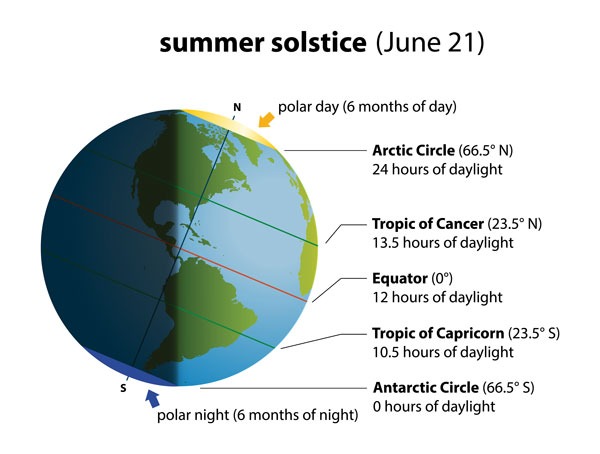
The official first day of summer is June 21 and there are plenty of reasons to welcome the season, from enjoying the outdoors and more. It’s the ideal day to plan a special summer hike or a family barbeque, because thanks to the summer solstice, you’ll have extra hours of sunlight for your favorite activities! In the Northern Hemisphere, the summer solstice marks the longest day of the year. In the United States, the solstice usually occurs on June 21. As the date approaches, the days get longer. Depending on where you live, you can expect 14-15 hours of sunlight on the summer solstice! If you’re a Community Solar customer, summer solstice can be a great day for solar energy production on the solar farms.
 During the summer months, solar energy production is at its highest, because the days are long and the bright summer sun shines directly over the Northern Hemisphere. As the days get shorter, solar production can begin to wane into the winter months. This is a natural part of the ebb and flow of solar energy production. Whether you subscribe to a Community Solar farm or have rooftop solar, your solar energy production will vary throughout the year, just like your home energy usage might vary with the seasons. The good news is, with Community Solar, we strategically place our solar panels to capture the greatest amount of sunlight, no matter what the season.
During the summer months, solar energy production is at its highest, because the days are long and the bright summer sun shines directly over the Northern Hemisphere. As the days get shorter, solar production can begin to wane into the winter months. This is a natural part of the ebb and flow of solar energy production. Whether you subscribe to a Community Solar farm or have rooftop solar, your solar energy production will vary throughout the year, just like your home energy usage might vary with the seasons. The good news is, with Community Solar, we strategically place our solar panels to capture the greatest amount of sunlight, no matter what the season.

During the winter, the Northern Hemisphere tilts away from the sun.
Why do the days get longer and shorter?
The Earth takes 24 hours to complete one full rotation on its axis, hence how we get our 24-hour days. It takes 365 days for the planet to fully rotate around the sun, resulting in our 365-day years. Finally, the Earth’s tilt is the reason that we have seasons.
The Earth is not perfectly vertical – in fact, the Earth has a tilt of about 23.5 degrees. As the Earth travels around the sun, a different part of the world tilts will toward the sun during different portions of the 365-day journey. In the summer, the Northern Hemisphere tilts toward the sun. This means longer days and more intense sunlight exposure. During the winter, the Northern Hemisphere tilts away from the sun, and thus shorter days and less sunlight.
Historical and Cultural Significance
The word “solstice” derives from the Latin sol (meaning sun) and stitium (meaning still) – together, “sun stands still.” The name comes from the ancient Greeks who noticed that around this time of year, the sun stopped moving north, and appeared to “hang” in the sky. Today, we know that the sun is not hanging, but instead, it is the earth’s tilt and rotation that cause the variations in sunlight we experience throughout the year.
Many cultures place significance on the summer solstice. The Ancient Greeks considered the summer solstice to be the beginning of the new year. Because of the importance of sunlight to agriculture, they often held feasts and festivals to honor the sun. Other cultures expressed the significance of the solstice through the construction of physical structures. Many scholars believe that the Celts in England constructed Stonehenge as a calendar to show the summer and winter solstice. The Maya in present-day Mexico and Central America kept records of the cycles of the sun, including the solstice, in their architecture. Over the years, celebrations have evolved. Today, in cities around the world, individual groups celebrate the solstice in their own way. Yoga, meditation, and drumming are popular ways of celebrating in the present day.
As you celebrate the power of the sun, think about how you can harness it for clean energy generation. Clearway Community Solar offers a convenient way to go solar without rooftop installation. You can capture the sun’s power for your community, and better manage your energy costs. Visit our Get Started page to learn more.









